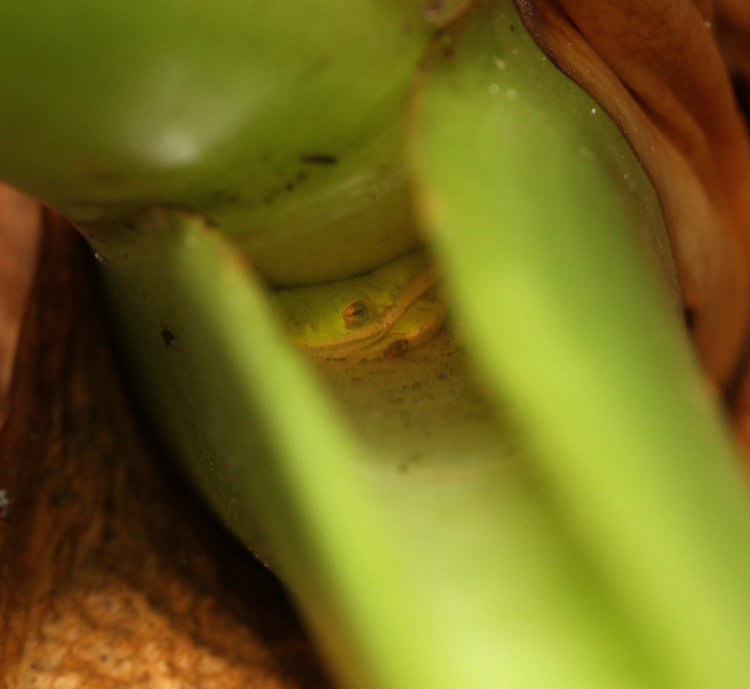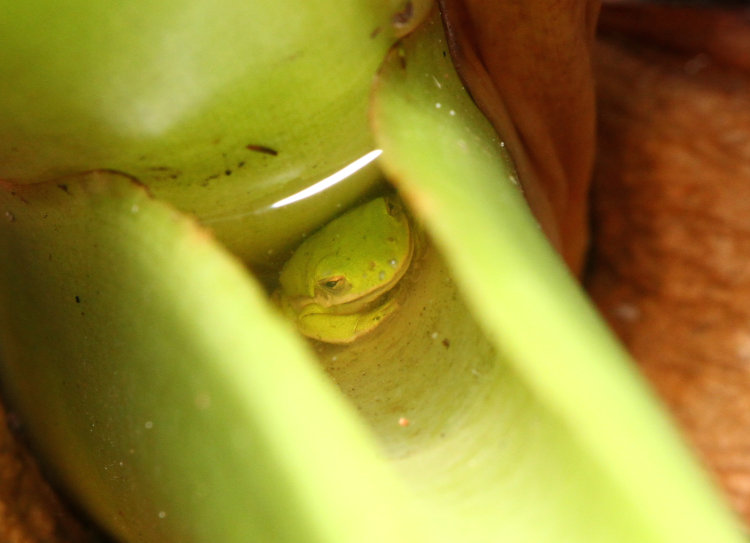You’ll notice that I corrected the roman numerals this time, after blowing it for the last two Estate Find posts – don’t ask me what I was thinking. And we have nothing new for this one, but we’ll feature two for the week anyway.
The first was done at the same time as the previous post’s pics, only about a meter or so away. I saw a flash of movement as I got closer, otherwise I likely would have missed this one.

This is so bizarre-looking because this juvenile green treefrog (Dryophytes cinereus) had backed quickly down under the water collected at the base of the elephant ear leaf stems, which distorted the view a bit. I would have liked to have captured it above the water’s surface a bit, but the frog wasn’t cooperating.
That was with the Sigma 180 macro. I returned a little later with the 18-135, again watching the frog duck back down out of sight. This time the focal length allowed more of the flash’s light to get in there.

I checked early in the evening too, but this guy had already headed out to do its damage to the local insect population.
And then we have more from the wood ducks, included again because the mob scene that now takes place really needs witnesses.
That is an almost disturbing number of wood ducks, and what’s startling to see is how they slip in almost unnoticed. They’re quite adept at using the existing cover to come in close, and will expand from a handful to a few dozen in mere seconds. And while occasionally we know what spooks them, such as the AC fan kicking on or the squirrels getting too excited, most times it’s a complete mystery why they suddenly all fly off, but it usually looks like one of them panics over something.
How many of these are the ducklings that we were watching earlier? It’s difficult to say, but if you look closely (especially right after they fly off farther into the pond,) you can see some males that don’t have as vivid or complete markings as the others, or seem a little smaller – these are likely some of the broods that were raised here this season. Most times, the pond is entirely quiet all day long, with the first calls that may be gathering the flock together starting in late afternoon. The video was shot just a little before sunset, but the ducks weren’t venturing out until the sun had dipped behind the trees, and it’s been made abundantly clear over the last year that this is completely intentional – it’s rare to see them in sunlight at all, so my attempts to get nice portraits that show off their iridescent feathers are usually thwarted.
Now, am I going to do a blind or something to get a closer, different vantage? Maaayyybe, though I’d have to be in position perhaps half an hour or more earlier and remain completely silent, with no movement showing, since we know how easy they are to spook. And simply the addition of the blind or camouflaging ‘stuff’ might be enough to make them too wary. I’ll think about it…



















































